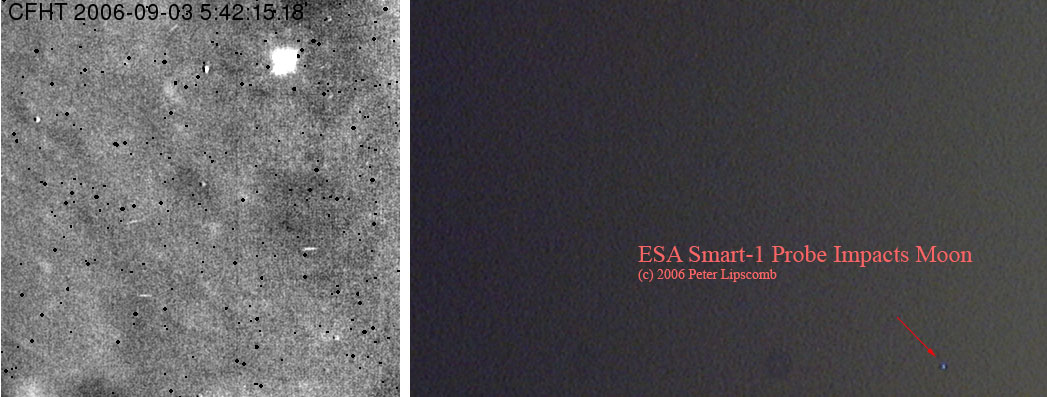
images by Canada-France-Hawaii Telescope / 2006, and Peter Lipscomb
One of the most highly anticipated observing opportunities for the Moon was a bust for most observers, generally because of clouds. So far I know, only two observations successfully captured the collision of the SMART-1 spacecraft onto the lunar surface on September 3, 2006. The left image was captured by Christian Veillet with the Canada-France-Hawaii Telescope of 140″ aperture high on the top of Mauna Kea volcano in Hawaii. The right image resulted from a webcam used by Peter Lipscomb with his Meade 8″ from his driveway in New Mexico. From dimensions given on the CFHT website I estimate the bright flash they imaged in the infrared (2.1 microns) was about 20 km wide. On Peter’s image the flash is an obvious, but little, blue dot. Peter’s Philips ToUcam Pro webcam is not sensitive in the IR so the flash he recorded may be a different diameter than as seen with the CFHT, and of course the image scales are vastly different. But Peter captured 5 frames per second, vs 10 second exposures for the 140″ which observed with a very narrow passband filter. I hope Peter will use image processing techniques to look for any hint of the brightening and dimming of the flash - if there are none it lasted 1/5th of a second or less. CFHT has just released an enhanced video that shows what is interpreted as a dust cloud. I estimate it covers 40-50 km and it seems to last a few tens of seconds. During high Sun conditions high resolution imagers should look for a new short, faint ray. So, a bright flash and faint dust cloud were detected, just as was hoped, but I am not sure what scientific understanding might come from these observations. As a historical note, despite many observers, no flash was detected when the Lunar Prospector was crashed into the lunar south pole in 1999, but a flash was reported when the lunar rocket, Luna 2, hit the Moon in 1959.
Related Links:
Peter’s website.
Yesterday's LPOD: A Quarter of the Farside
Tomorrow's LPOD: A Table of Contents
COMMENTS?
Register, Log in, and join in the comments.



